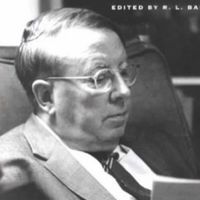
Yvor Winters
Arthur Yvor Winters (17 October 1900– 25 January 1968) was an American poet and literary critic.
Arthur Yvor Winters (17 October 1900– 25 January 1968) was an American poet and literary critic.
Life
Winters was born in Chicago, Illinois and he grew up in Eagle Rock, California. He attended the University of Chicago where he was a member of a literary circle that included Glenway Wescott, Elizabeth Madox Roberts and his future wife Janet Lewis. He suffered from tuberculosis in his late teens and moved to Santa Fe, New Mexico. There he recuperated, wrote his early published verse and taught. In 1923 Winters published one of his first critical essays, “Notes on the Mechanics of the Poetic Image,” in the expatriate literary journal Secession. In 1925 he became an undergraduate at the University of Colorado.
In 1926, Winters married the poet and novelist Janet Lewis, also from Chicago and a tuberculosis sufferer. After graduating he taught at the University of Idaho and then started a doctorate at Stanford University. He remained at Stanford, living in Los Altos, until two years before his death from throat cancer. His students included the poets Edgar Bowers, Thom Gunn, Donald Hall, Jim McMichael, N. Scott Momaday, Robert Pinsky, John Matthias, Moore Moran, Roger Dickinson-Brown and Robert Hass, the critic Gerald Graff, and the theater director and writer Herbert Blau. He was also a mentor to Donald Justice, J.V. Cunningham and Bunichi Kagawa.
He edited the literary magazine Gyroscope with his wife from 1929 to 1931; and Hound & Horn from 1932 to 1934.
He was awarded the 1961 Bollingen Prize for Poetry for his Collected Poems.
As modernist
Winters’s early poetry appeared in small avant-garde magazines alongside work by writers like James Joyce and Gertrude Stein and was written in the modernist idiom; it was heavily influenced both by Native American poetry and by Imagism, being described as 'arriving late at the Imagist feast’. His essay, “The Testament of a Stone,” gives an account of his poetics during this early period. Although beginning his career as an admirer and imitator of the Imagist poets, Winters by the end of the 1920s had formulated a neo-classic poetics. Around 1930, he turned away from modernism and developed an Augustan style of writing, notable for its clarity of statement and its formality of rhyme and rhythm, with most of his poetry thereafter being in the accentual-syllabic form.
As critic
Winters’s critical style was comparable to that of F. R. Leavis, and in the same way he created a school of students (of mixed loyalty). His affiliations and proposed canon, however, were quite different: Edith Wharton’s The Age of Innocence above any one novel by Henry James, Robert Bridges above T. S. Eliot, Charles Churchill above Alexander Pope, Fulke Greville and George Gascoigne above Sidney and Spenser. In his view, “a poem in the first place should offer us a new perception . . . bringing into being a new experience.”
He attacked Romanticism, particularly in its American manifestations, and assailed Emerson’s reputation as that of a sacred cow. Ironically, his first book of poems, Diadems and Fagots, takes its title from one of Emerson’s poems. In this he was probably influenced by Irving Babbitt. Winters was sometimes and questionably associated with the New Criticism, largely because John Crowe Ransom devoted a chapter to him in his book of the same name. He bestowed the sobriquet “the cool master” on the American poet Wallace Stevens.
Winters is best known for his argument attacking the “fallacy of imitative form”:
“To say that a poet is justified in employing a disintegrating form in order to express a feeling of disintegration, is merely a sophistical justification for bad poetry, akin to the Whitmanian notion that one must write loose and sprawling poetry to 'express’ the loose and sprawling American continent. In fact, all feeling, if one gives oneself (that is, one’s form) up to it, is a way of disintegration; poetic form is by definition a means to arrest the disintegration and order the feeling; and in so far as any poetry tends toward the formless, it fails to be expressive of anything.”
Bibliography
Diadems and Fagots (1921) poems
The Immobile Wind (1921) poems
The Magpie’s Shadow (1922) poems
Secession certain Notes on the Mechanics of the Image (1923) a magazine
The Bare Hills (1927) poems
The Proof (1930) poems
The Journey and Other Poems (1931) poems
Before Disaster (1934) poems
Primitivism and Decadence: A Study of American Experimental Poetry Arrow Editions, New York, 1937
Maule’s Curse: Seven Studies in the History of American Obscurantism (1938)
Poems (1940)
The Giant Weapon (1943) poems
The Anatomy of Nonsense (1943)
Edwin Arlington Robinson (1946)
In Defense of Reason (1947) collects Primitivism, Maule and Anatomy
To the Holy Spirit (1947) poems
Three Poems (1950)
Collected Poems (1952, revised 1960)
The Function of Criticism: Problems and Exercises (1957)
On Modern Poets: Stevens, Eliot, Ransom, Crane, Hopkins, Frost (1959)
The Early Poems of Yvor Winters, 1920–1928 (1966)
Forms of Discovery: Critical and Historical Essays on the Forms of the Short Poem in English (1967)
Uncollected Essays and Reviews (1976)
The Collected Poems of Yvor Winters; with an introduction by Donald Davie (1978)
Uncollected Poems 1919–1928 (1997)
Uncollected Poems 1929–1957 (1997)
Yvor Winters: Selected Poems (2003) edited by Thom Gunn
As editor
Twelve Poets of the Pacific (1937)
Selected Poems, by Elizabeth Daryush (1948); with a foreword by Winters
Poets of the Pacific, Second Series (1949)
Quest for Reality: An Anthology of Short Poems in English (1969); with, and with an introduction by, Kenneth Fields
References
Wikipedia—https://en.wikipedia.org/wiki/Yvor_Winters


